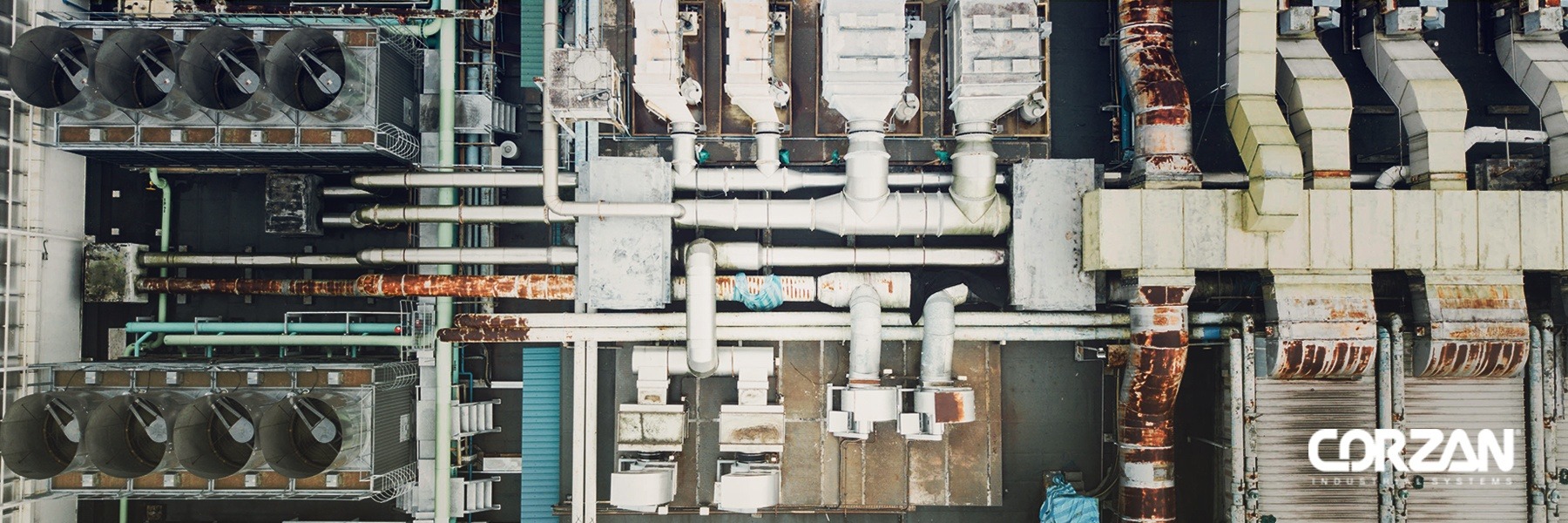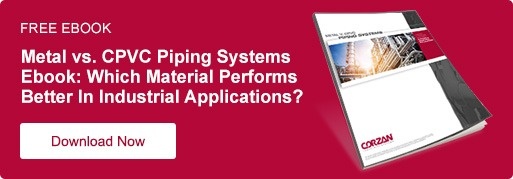How to Integrate CPVC Into Existing Piping Systems
Every now and then, piping systems require upgrades or repairs, whether as a result of expected chemical corrosion or accidental pipe damage. Alternatively, industrial plants will often pilot test a small run of CPVC in an existing system to verify its compatibility and reliability.
When the need to integrate CPVC pipe into an existing system arises, engineers have two priorities: minimize downtime and maximize value—including material costs, labor costs and system lifecycle.
Whether your existing system is CPVC, another thermoplastic or metal, CPVC piping may be the ideal replacement solution thanks to its chemical resistance and compatibility, high heat distortion temperature and pressure rating.
Fortunately, integrating CPVC into an existing system, regardless of the existing material, is a relatively easy, straightforward process.
Integrating CPVC Into an Existing CPVC System
Installers can choose between two preferred methods when integrating CPVC into an existing CPVC system. Depending on available time, budget and system demands, solvent cement welding and mechanical couplings are available options.
Repairing a CPVC System with Solvent Cement Welding
Solvent cement welding is typically the preferred joining method of CPVC piping systems, as it fuses the material at the molecular level, essentially establishing one uniform piece of plastic.
To make a successful CPVC system repair using solvent cement, follow these steps:
- Measure the damaged section to be replaced.
- Cut the measured section out cleanly, using a preferred cutting method.
- Prepare the new CPVC pipe and cut it evenly—easily performed onsite.
- Ensure the piece is dry, and follow the solvent cementing best practices to properly join the new CPVC pipe and couplings to the existing system.
Repairing CPVC with Mechanical Couplings
Mechanical couplings offer an alternative joining method for repairing CPVC that does not require curing time. These are metal clamps with rubber gaskets in the middle. Though often more expensive than solvent cemented joints, mechanical couplings allow systems to quickly return to processing after installation.
When repairing CPVC with mechanical couplings:
- Groove the piping, which can be done in the field by following the appropriate steps.
- Apply a thin coat of compatible lubricant to the sealing lips of the gasket.
- Insert the grooved end of the pipe into the end of the coupling, then repeat with the other side.
- Tighten the coupling evenly until metal-to-metal contact occurs at the bolt pads.
- Visually inspect the bolt pads at each joint to ensure sufficient contact.
- Restart the system and continue processing.
Be cognizant of dissimilar gasket and coupling materials, as these may react differently to chemicals in the fluid stream than the CPVC. Additionally, pipe turns or twists can be a source of leakage in suboptimal couplings.
For mechanical couplings specially designed to meet the pressure rating and chemical compatibility of Corzan® CPVC, check out Victaulic. They ensure the couplings will not limit the existing system or material and also offer an installation manual and helpful training videos.
Integrating CPVC into a Metal/Mixed Piping System
When integrating CPVC into a metal or mixed system, plant managers and engineers may have concerns about its performance capabilities and installation methods.
To sufficiently meet industrial system demands, Corzan CPVC is pressure rated up to 200°F (93.3°C). Additionally, CPVC is inherently resistant to the affects of many acids, bases and salts.
In terms of installation, CPVC can also decrease downtime and cost, as it does not require power tools or heavy equipment. Also, the installation process can be learned quickly, eliminating the need for specialized personnel.
Test pieces are sometimes installed in complex chemical streams to assess compatibility and life expectancy. In applications where compatibility is well documented, whole sections of metal pipe can be replaced with confidence.
Learn more about how CPVC compares to metal in a number of key categories in our resource article, Metal v. CPVC Piping Systems.
Repairing a Metal/Mixed System with Flanges
Integrating CPVC to a metal piping system can be a simple job with this effective approach:
- Measure the sections of piping to be replaced at the nearest flanges. More piping may be removed than absolutely necessary, but this method generally creates the strongest bond for CPVC and may minimize downtime.
- Prefabricate the replacement piece and its flanged joints wherever possible before bringing down the system. This will leave only a simple process to move the lightweight piping into place and bolt the flanges.
- Remove the metal flange and pipe to be replaced.
- Bolt the new flange to the one attached to the system. Flanges made of two different materials will remain strong, so long as they are properly bolted together.
Because CPVC is lightweight and easy to install in the field, repairs can be made with limited downtime. Follow the same best practices we’ve recommended for solvent cement welding to prefabricate your CPVC piping sections quickly and reliably.
Repairing a Metal/Mixed System with Mechanical Couplings
Another attractive option for integrating CPVC into a metal or mixed piping system is the use of mechanical couplings. If correct mechanical couplings, with compatible gaskets, are selected and installed correctly, the system will experience no deration beyond the operating range of the CPVC piping system. Additionally, this joining method eliminates the need for curing, minimizing system downtime.
Mechanical couplings can be used to integrate CPVC into a metal or mixed system by:
- Measure the sections of piping to be replaced.
- Cut the CPVC piping to the correct length and groove the new CPVC piping, which both are easily accomplished by following the correct steps.
- Groove the metal pipe according to the specification of the transition coupling being used.
- Apply a thin coat of compatible lubricant to the sealing lips of the gasket.
- Insert the grooved end of the pipe into the CPVC end of the coupling.
- Tighten the coupling evenly until metal-to-metal contact occurs at the bolt pads.
- Insert the valve into the metal end of the coupling until contact with the center leg of the gasket occurs.
- Complete the same process with the opposite coupling end.
- Visually inspect the bolt pads at each joint to ensure sufficient contact.
- Restart the system and continue processing.
If you need help selecting the best method for your process, as well as the appropriate compatible materials, ask for technical support.
See How CPVC Compares to Metal Piping Systems
If you need more information on how a CPVC system stands up against a metal piping system, learn more in the resource article, Metal v. CPVC Piping Systems — Can CPVC outperform metal piping in industrial applications?. Our team of engineering and product experts compares CPVC piping to metal in terms of temperature, pressure, and corrosion resistance, cost and safety.


